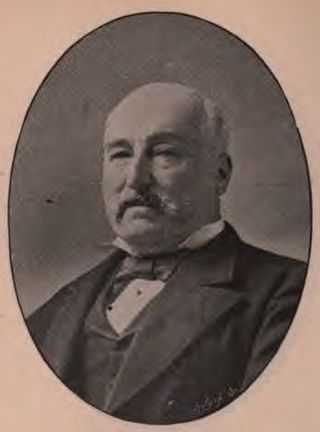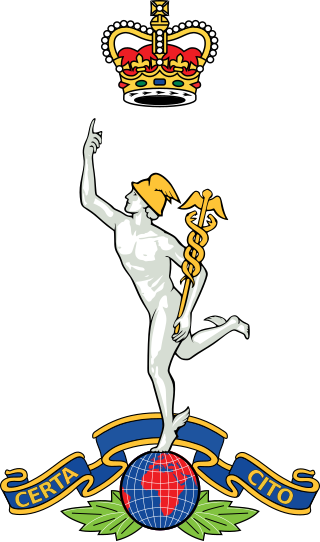
Sir Charles Mark Palmer, 1st Baronet was an English shipbuilder born in South Shields, County Durham, England. He was also a Liberal Party politician and Member of Parliament. His father, originally the captain of a whaler, moved in 1828 to Newcastle upon Tyne, where he owned a ship owning and ship-broking business.

The Kent Fortress Royal Engineers (KFRE) was a volunteer Territorial unit of the British Army that saw service in both World Wars. They are notable for their successful actions in May 1940, when they destroyed substantial oil stocks and installations just ahead of the German advance, and in August 1944 during the assault crossing of the River Seine.

The 1st London Field Company, Royal Engineers was a Territorial engineer unit of the British Army active during World War I. Formed in 1908, it was based in Bethnal Green in East London.

The 1st Hampshire Engineer Volunteer Corps was first formed in 1862 and then reformed in 1891 with special responsibility for the port defences of the South Coast of England. It carried out this role during World War I, as well as forming field units that served on the Western Front and at Salonika. Before the outbreak of World War II it formed an air defence regiment that saw service during The Blitz and field companies that fought in the Western Desert and Italy, The unit continued in the postwar Territorial Army before finally disbanding in 1967.
The Tyne Electrical Engineers (TEE) is a Volunteer unit of the British Army that has existed under various titles since 1860. It has been the parent unit for a large number of units fulfilling specialist coastal and air defence roles in the Royal Engineers (RE) and Royal Artillery (RA), many seeing service during both World Wars. TEE companies currently form part of the RE and of the Royal Electrical and Mechanical Engineers in the Army Reserve.
The 1st Newcastle Engineer Volunteers, later Northumbrian Divisional Engineers, was a Royal Engineer (RE) unit of Britain's Volunteer Force and Territorial Army founded in 1860. Its companies saw action in both World Wars, particularly at the Battle of Rosières and the assault crossing of the River Selle in 1918, and on D-Day in 1944. Its successors continue to serve in today's Army Reserve.

The Cinque Ports Fortress Royal Engineers was a volunteer unit of Britain's Royal Engineers serving in the defences of Dover, one of the historic Cinque Ports. It provided detachments for field service in World War I and in World War II, when they saw active service in Tunisia, Italy and Greece. Its lineal descendant continues to serve in the present day Army Reserve as a bomb disposal unit.
The City of Edinburgh (Fortress) Royal Engineers was a volunteer unit of the British Army under various titles from 1886 until 1999. Its main role was defence of the Firth of Forth, but it also provided detachments for active service in the field during both World Wars.
The North Midland Divisional Engineers was a Territorial Force unit of the British Royal Engineers created in 1908 by conversion of a volunteer infantry battalion from Staffordshire. It saw action in World War I at the Hohenzollern Redoubt, Gommecourt, Ypres, Cambrai, the German spring offensive and the Hundred Days Offensive, culminating in the assault crossings of the St Quentin Canal, the Selle and the Sambre. During World War II its component units saw action in the Battle of France, in Greece, Tunisia, Italy, Normandy and the Rhine crossing.
The Renfrewshire Fortress Royal Engineers was a Scottish volunteer unit of the British Army under various titles from 1888. Its main role was defence of the ports and shipyards on the River Clyde, but it also provided detachments for active service in the field during both World Wars. Its successors continue to serve in the Army Reserve.

The Dundee Fortress Royal Engineers was a Scottish volunteer unit of the British Army formed in 1908. Its main role was the defence of the harbours and shipyards on the River Tay, but it also provided a detachment that saw active service in North Russia at the end of World War I. In the 1930s, it was turned into an air defence unit, in which role it served in World War II. A brief postwar revival ended in disbandment in 1950.
The 1st Lancashire Engineer Volunteer Corps was a Volunteer unit of Britain's Royal Engineers, first raised in 1860. It went on to spin off a unit of fortress engineers and provided a signals training centre during World War I. Its successor units provided signal support for West Lancashire Territorial Army (TA) formations in the early stages of World War II, and for Eighth Army HQ during the Second Battle of El Alamein, the advance to Tunis, invasion of Sicily and through Italy, ending the war in Austria. Postwar successor units have continued in the TA and Army Reserve to the present day.
The Lancashire (Fortress) Royal Engineers was a volunteer unit of Britain's Royal Engineers formed in 1884 to defend the Mersey Estuary. As well as serving in this role it also provided specialist engineer units in both World Wars, losing many men in a shipping disaster during the Greek Campaign. Its descendants continued to serve in the Territorial Army until 1967.

The East Riding (Fortress) Royal Engineers was a volunteer unit of Britain's Royal Engineers formed for the defence of the Humber Estuary in the East Riding of Yorkshire. As well as serving in this role it also provided field and specialist engineer units in both World Wars. Its successors continued to serve in the Territorial Army until 1991.
The North Riding (Fortress) Royal Engineers was a volunteer unit of Britain's Royal Engineers formed for the defence of the Tees Estuary in the North Riding of Yorkshire. As well as serving in this role it also provided specialist engineer units in both World Wars. Its descendants continued to serve in the Territorial Army until 1999.

The 1st Devonshire Engineer Volunteer Corps, later the Devonshire Fortress Royal Engineers, was a volunteer unit of Britain's Royal Engineers whose history dated back to 1862. The unit helped to defend the vital naval base of Plymouth, and supplied detachments for service in the field in both World Wars. During the North African campaign in World War II, the unit's sappers distinguished themselves in bridging the Nile and clearing minefields during and after El Alamein. Their successors served on the postwar Territorial Army until 1969.

The Tower Hamlets Engineers was a Volunteer unit of the British Royal Engineers (RE) based in East London. Raised in 1868, it provided engineers for two London infantry divisions of the Territorial Force during World War I. In World War II it operated as an RE headquarters, particularly on D-Day and at the Rhine Crossing, while its subordinate companies served in a number of campaigns, including the Siege of Tobruk and with the Chindits. Its successor unit continues to serve in today's Army Reserve.
The 1st Somersetshire Engineers was a volunteer unit of Britain's Royal Engineers (RE) whose history dated back to 1868. As the engineer component of the 43rd (Wessex) Division, the unit served in both World Wars, distinguishing itself at the assault crossing of the River Seine at Vernon in August 1944 and in the doomed attempt to relieve the 1st Airborne Division at Arnhem. A detachment also served as airborne engineers in Sicily, Italy and at Arnhem. Their successors served on in the Territorial Army until 1967.
The Glamorgan Fortress Royal Engineers was a Welsh Territorial Army (TA) unit of Britain's Royal Engineers, first raised in 1885 as a Volunteer unit of Submarine Miners to defend the Severn Estuary. During World War I it carried out defence work in England and Gibraltar, and detachments served on the Western Front. In World War II it served in the North African campaign, including the Second Battle of El Alamein, and the Allied invasion of Sicily. Postwar, the unit continued in the TA until 1961.

43 (Wessex) Signal Regiment was a Territorial Army (TA) unit of the British Army's Royal Corps of Signals from 1920. It had its origins in a Volunteer unit of the Royal Engineers formed in the West Country in 1860 and provided the communications for the 43rd (Wessex) Infantry Division during World War II. Its successor still serves as a squadron in today's Army Reserve.







